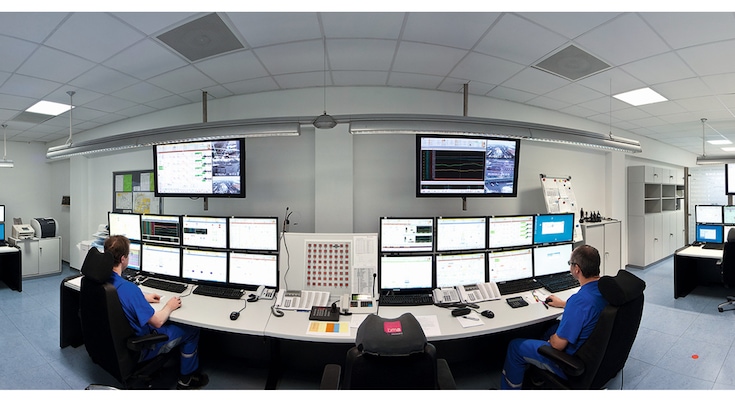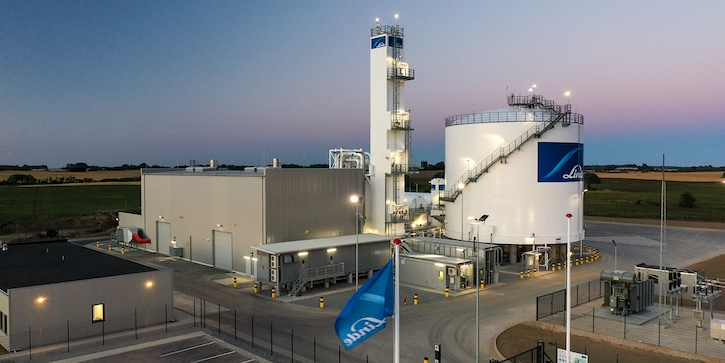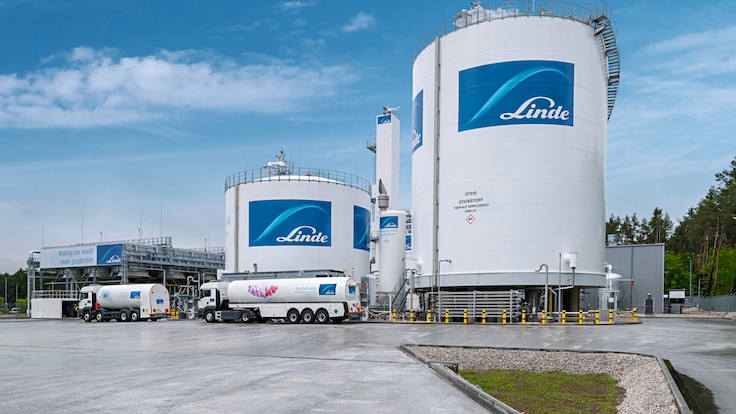
Type in the values of the production case you want to analyse.
The ability to harness wind and solar power is driving the transition to a more sustainable energy economy.

However, feeding energy from fluctuating renewable sources into the grid without compromising network stability remains a challenging task. Industrial consumers can help grid operators by adapting their production processes to the natural fluctuations in energy supply. With its FLEXASU® project, Linde Engineering aims to make a valuable contribution to a successful shift in the energy landscape.
Just a short while ago, this wind farm was being buffeted by strong gusts of wind. Now, all that’s left is a weak breeze wafting gently over the turbine blades. The amount of power generated here fluctuates wildly. These situations are a real challenge for power grids. Fluctuations in power must be balanced throughout the day and night. For grid operators to provide a secure supply of electricity around the clock, supply and demand must be perfectly synchronized. “As we transition to a more sustainable energy economy, however, the share of renewables in the mix is increasing, making grids unstable. Industrial consumers can help balance grids by increasing the flexibility of their production plants and using more electricity when it is readily available,” explains Dr. Christoph Windmeier, Technical Project Manager of the FLEXASU project at Linde Engineering. “In simple terms, this means front-loading production during times when there is an excess of electricity and it is therefore cheap. Manufacturers can store these gas reserves and then cut back on production when energy is scarce and subsequently more expensive.” Intelligently adapting consumption in this way is known as demand-side management (DSM) – an approach that can help balance grids and also translate into cost efficiencies for operators.
“We are supporting the transition to a more sustainable energy economy with our new FLEXASU® concept.”

What may seem like a simple, self-evident solution actually reveals a number of technical challenges. To enable this transition to renewables, Linde Engineering is developing its FLEXASU concept. The concept is part of the SynErgie Kopernikus project, which is funded by Germany’s Federal Ministry of Education and Research, and brings together a number of partners. “The FLEXASU project enables operators of air separation units or ASUs to adapt the production and liquefaction of gases such as oxygen and nitrogen to market dynamics,” elaborates Stefan Lochner, who heads up the FLEXASU Project at Linde Engineering. The new concept allows operators to do this without impacting average production, ensuring uninterrupted supplies to customers. “Until now, ASUs were designed for continuous operation. As such, load changes were rare and usually only occurred for maintenance windows. As we transition to more sustainable energy sources, fluctuations could become a regular occurrence,” adds Andreas Obermeier, engineer at Linde Engineering. “With FLEXASU, we want to design and operate plants that are optimized specifically for this type of production flexibility,” says Lochner. This means adapting plant components to support a dynamic mode of operation and fine-tuning the design. In addition, the instrumentation and control technology has to be refined to support more flexible operations with frequent load changes.

To avoid damaging the plant during load changes, Linde’s engineers are taking a close look at every component in an ASU, modifying the design and making it more robust where necessary. This can include making the walls of pipelines thicker, allowing them to cope with more frequent changes in pressure. The engineers also modify other integral components such as valves, compressors and pumps. “Just like a jigsaw puzzle, there are lots of individual parts that come together as a whole to help make ASUs more flexible,” explains Linde expert Windmeier. “We can already achieve a lot, for example, by installing an additional pump that feeds liquid product from the tanks back into the unit to reduce power consumption,” continues Obermeier. “In some ASUs, this can cut consumption by approximately 80 percent in around ten minutes.” Larger tanks can also be installed to store the liquid gases produced by an ASU – another piece of the jigsaw that helps increase flexibility. A larger storage tank gives an ASU more buffering flexibility. “The idea here is to offset fluctuations in the electricity market by providing larger tanks with greater capacity to store product,” outlines Lochner. This approach also helps increase supply security for Linde customers.
For Linde Engineering, FLEXASU is about much more than just modifying hardware components for dynamic load changes. The experts have also developed a tool to determine the optimum operating plan, factoring in energy market forecasts and production volume planning. Big data offers further opportunities to generate these kinds of predictions to a high degree of accuracy. “External service providers, for example, already offer tools that predict trends in energy markets, combining weather records and forecasts with up-to-the-minute reports,” says Obermeier. “All of these developments are combining to power the transition to a more sustainable energy mix. Plants that are equipped to master the flexibility challenge will also offer financial benefits.”

In the meantime, specialists at Linde Engineering’s R&D center are collaborating with experts from the Technical University of Munich to run a series of measurements exploring various questions. For instance, what kinds of loads are heat exchangers subjected to during flexible operation? What impact do variable loads have on materials? How can these loads be minimized? Other project partners such as MAN and the Bundeswehr University Munich are working to improve compressor technology. The RWTH Aachen University, on the other hand, is optimizing the instrumentation and control technology for flexible plant operations. “The initial findings and resulting modifications are being channeled into some of our current unit designs. We have already realized a modern air separation unit with flexibility modifications,” explains Lochner. “The unit produces liquid oxygen and nitrogen for the market, which is transported to customers by truck.”
Although FLEXASU is an ongoing project, Linde’s engineers are gradually reaping early rewards. A number of measures that enable flexible operations are already market ready – or will be very shortly. Linde Engineering also aims to use the findings it has gained through this project to modernize older plants, enabling them to be operated in a more flexible way. “This will be possible up to a certain point,” says Obermeier. “However, in simple terms, it will involve more than just integrating a digital tool into a plant or installing extra pumps.” To capitalize on the full potential of dynamic plant operations, all hardware components must be perfectly aligned. FLEXASU is more than a technical concept. It enables industrial consumers to support the transition to greener forms of energy. But it also represents a paradigm shift in the way air separation units are designed and operated.